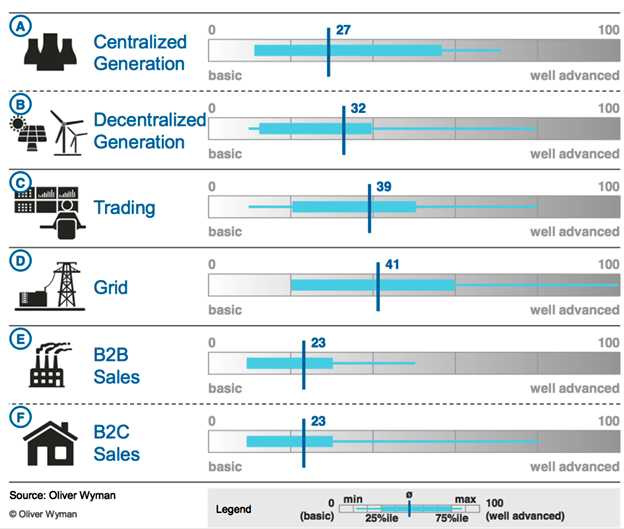Marius Buchmann
German utilities claim that they are becoming consumer-centred, service-based organisations, but research from Oliver Wyman shows that in actual fact their market share in the digitalized retail market is very small, writes energy economist Marius Buchmann of Jacobs University in Bremen. But they may still deliver on their promise: they are ready to launch digital attackers.
Utilities around the globe are currently adapting their business model to the 3 Ds “Decentralization, Decarbonization and Digitalization”. Especially in the medium and long run it seems to be the consensus that utilities need to change their asset-based business model towards a service-based model.
We have discussed in an earlier post (see here for details) a range of potential business models for utilities from a pure asset-focus to digital service companies. Most prominently, the two German utilities E.On and RWE split their core business units into two different companies: an asset-based and a service-based part (though in both cases the service-based part is backed up by regulated income from network ownership and operation, for more details on the strategies of E.On, Innogy and RWE take a look here). Other utilities around the globe are acting similarly or are currently in the process to develop a service-based approach, writes Marius Buchmann for energypost.eu.
Two areas in the service-based area seem to become very important now, at least for the private household sector: smart home assets & applications (enabled by the Internet of Things – IoT) and digital products that are based on data rather than assets.
Utilities do not have a dominant position in the smart home market
The smart home market is highly competitive and nearly all utilities as well as big players from other industries like Google, Apple and Ikea have entered the market as well. Though the utilities have the advantage that they already have their customer base and different existing contact channels, they are still struggling to gain a foothold in the smart home market.
Even though the data from McKinsey (2016) shows that utilities cover about 15-20% of the relevant market, utilities do not have a dominant position in this market. Even contractors or cable companies reach similar market shares at around 12-15%, despite the fact that they do not have the utilities’ energy expertise.
I do not have the similar data on the German market available, but the experience from the US might serve as a good estimate, even though the German market is less mature than the smart home market in the US.
Utilities struggle with digitalization – especially in retail
Similar to the smart home market, utilities are struggling to make use of digitalization in the customer segment. Last week, I met with Dr. Thomas Fritz who is a Partner at Oliver Wyman consulting group and who presented to me the Digitalization Index German Utilities developed by Oliver Wyman.
The index aims to indicate how German utilities are performing with respect to digitalization. Figure 2 gives an overview of the different parts of the electricity supply chain and how each segment performs with respect to digitalization.
Importantly, Oliver Wyman used a best-in class approach, meaning that the full score of 100 represents an available digital solution in the market, not the theoretical potential (Oliver Wyman, 2017).
Though the index is only indicative and the degree of digitalization differs between the individual utilities in Germany, the results for the B2B and B2C retail sector are quite disillusioning. Both segments score the lowest of all segments of the electricity sector with respect to digitalization.
If we take into account that the network segment reached the highest score in this index, and if we also take into account that the distribution grids in Germany (at least on the low-voltage level) are a black box where even the DSOs do not have much data available, then the low score of the retail sector becomes even more astonishing!
Leaving aside the question whether the index gives a realistic picture (and I think it is a quite good estimate of the current situation) the relation between the different results in the different segments tells us that the retail sector on average has not yet picked up the potential of digital processes and services.

